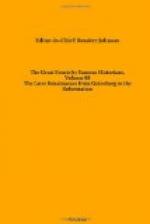I have not considered it necessary to prove that if Cabot’s landfall were Cape North he could not have discovered the low lying shore of Prince Edward Island on the same day. I have preferred to show that Prince Edward Island was not known as an island and did not appear on any map for one hundred years after John Cabot’s death. If Cabot had possessed a modern map, and had been looking for Prince Edward Island, and had pushed on without landing at the north cape of Cape Breton, and had shaped his course southward, he might have seen it in a long Midsummer Day, but Cabot did not press on. He landed and examined the country, and found close to it St. John’s Island, which he also examined. Upon that easternmost point of this Nova Scotian land of our common country John Cabot planted the banner of St. George on June 24, 1497, more than one year before Columbus set foot upon the main continent of America, and now, after four hundred years, despite all the chances and changes of this Western World, that banner is floating there, a witness to our existing union with our distant mother-land across the ocean.
THE SEA ROUTE TO INDIA
VASCO DA GAMA SAILS AROUND AFRICA
A.D. 1498
CASPAR CORREA[1]
The same goal which attracted the Spaniards westward drew the Portuguese south, the desire to find a sea route to India, and thus garner the enormous profits of the trade in spices and other Indian wealth. In the early years of the fifteenth century the Portuguese, overshadowed by the Spanish kingdom, which almost enclosed their country, realized that they could extend their territory only by colonizing beyond seas. They began, therefore, to send out expeditions, and in 1410 discovered the island of Madeira. Soon afterward discoveries were undertaken by Prince Henry, called the “Navigator,” whose whole life was given to these enterprises. Before his death, 1460, his Portuguese mariners, in successive voyages, had worked their way well down the western coast of Africa. In 1462 an expedition reached Sierra Leone, almost half way down the continent. Nine years later the equator was passed, and in 1486 Bartholomew Dias sailed around the southern point of Africa, which he had been sent to discover. On his return voyage, 1487, he found the Cape of Good Hope, having before doubled it without knowing that he had done so.[2]
To Portuguese navigators the way to India by this route was soon made clear. In 1497 Vasco da Gama was placed by King Emanuel I of Portugal in command of an expedition of three small ships sent to discover such a route. He sailed from Lisbon in July of that year, in November doubled the Cape of Good Hope, arrived at Calicut, on the Malabar coast of India, in May, 1498, and in September, 1499, returned to Lisbon. He was accompanied by his brother Paulo, who, with other of the celebrated navigator’s companions, appears in the following account of this great achievement. The quaint narrative was written by the chronicler who accompanied the expedition in person.




